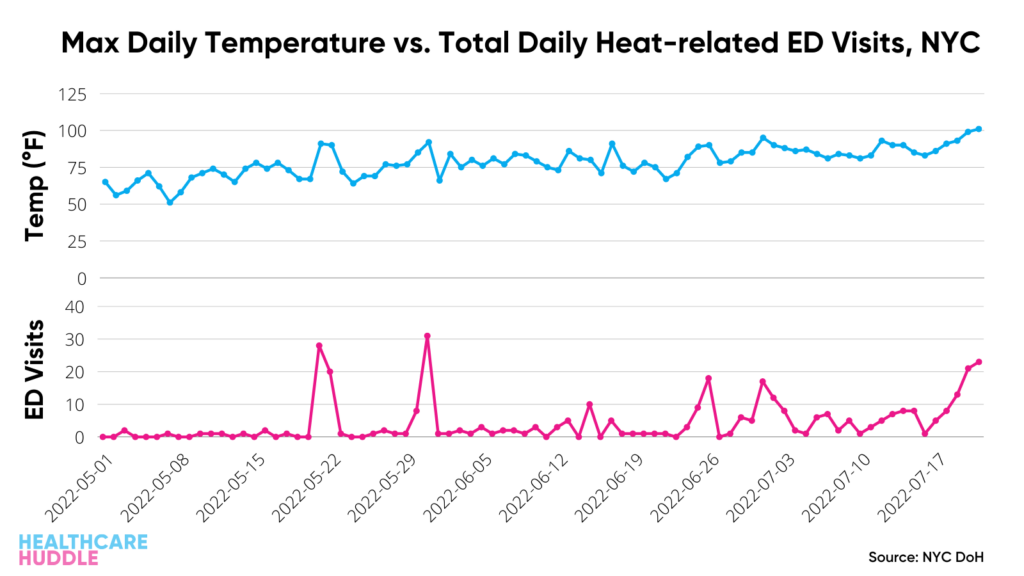23 July 2022 | Healthcare
Heat Waves
By workweek
Western Europe experienced an unprecedented heat wave. Fires ensued, high ozone levels exacerbated respiratory illnesses and airport runways melted. Is this a one-off occurrence? Absolutely not.
The Deets
In Western Europe, places that considered 80 degrees to be “hot” dealt with temperatures well over 100 degrees. As I write this article in my NYC apartment, it’s 95 degrees outside. I have my AC blasting, though. Given Western European countries infrequently experience such heat waves, they were unprepared for such temperatures—only three to five percent of Britons have air conditioning, for example.
These heat waves cannot be ignored given their health impact. In Portugal alone, 1,000 people died due to the extreme weather. Unfortunately, extreme heat events are just firing up.
Climate Change Refresher
Human-induced climate change is a world crisis. And, we humans—specifically those in industrialized countries—are largely to blame, given our reliance on fossil fuels that increase the concentration of greenhouse emissions. Ironically, U.S. hospitals are the world’s thirteenth largest emitters of greenhouse gasses, contributing 10% to global emissions (higher than the entire UK).
Since 1900, earth temperatures have increased 1.1° Celsius (1.9° Fahrenheit). Studies suggest maintaining increases of less than 1.5 degrees Celsius (2.7° Fahrenheit) is necessary to prevent devastating impacts on human health. It looks like we’ll surpass that limit within 20 years. The impact on health and societies will be devastating, causing excess morbidity and mortality.
We’re already seeing such adverse health effects: one-third of all heat-related deaths within the past 30 years are directly due to climate change. Last year, the U.S. Pacific North West experienced a heat wave reaching 46° Celsius (116° Fahrenheit). Emergency Department visits increased 69-fold for heat stroke, heat exhaustion and exacerbation of chronic conditions.
Heat is particularly worse in urban settings because of the Urban Heat Island Effect, where roads and buildings in urban areas absorb and reemit heat. This causes urban temperatures to be around 10° Celsius (18° Fahrenheit) higher than in nonurban areas. As such, extreme heat won’t affect everyone equally. Low-income urban neighborhoods are at increased risk of adverse health consequences from extreme heat, as are children, pregnant, older, or housing insecure.

Dash’s Dissection
The best we—people in healthcare—can do now regarding climate change is to prevent further temperature changes and prepare for extreme weather events.
Preventing further temperature changes means lowering greenhouse emissions. As I mentioned above, U.S. hospitals significantly contribute to greenhouse emissions. The government can further incentivize hospitals to reduce energy demands. For example, hospitals can add green or reflective rooftops which can be 30°-40° Fahrenheit lower than conventional rooftops. Hospitals can also invest in urban greening projects, which have several benefits: increasing tree canopies and vegetation-covered surfaces may decrease daytime air temperatures and reduce population exposure to heat.
Preparing for extreme weather events means making sure hospitals and public health organizations are equipped to manage extreme weather emergencies and health complications due to extreme weather. This may involve creating, or refurbishing, community centers with air conditioning, allowing people without homes to pass the day in such settings to avoid heat exposure. Public health officials could also launch public health campaigns, educating the public on what to do when the forecast includes extreme heat. They may even go a step further and preemptively prepare vulnerable populations for extreme heat. New York City, for example, has a climate and health hub, where you can find heat maps of different areas within the city.

Residents of Harlem and Queens will be disproportionately affected by heat waves, so public health groups could intervene before health consequences are realized, for example.
There are a plethora of interventions to combat climate change. It’s just a matter of getting everyone on board. We can’t wait any longer to do something. Look how it turned out for the frog who didn’t realize it was in boiling water.
For more content like this, sign up for the weekly Healthcare Huddle newsletter.